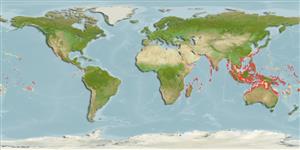Environment: milieu / climate zone / depth range / distribution range
Écologie
marin récifal; profondeur 2 - 40 m (Ref. 1602). Tropical; 32°N - 32°S
Indo-Pacific: Sri Lanka east to Samoa and Tonga (Ref. 2334), north to Japan (Ref. 559), south to Onslow, Australia.
Taille / Poids / Âge
Maturity: Lm ? range ? - ? cm
Max length : 25.0 cm TL mâle / non sexé; (Ref. 2334); common length : 12.5 cm TL mâle / non sexé; (Ref. 9893)
Épines dorsales (Total) : 0; Rayons mous dorsaux (Total) : 62 - 73; Épines anales: 0; Rayons mous anaux: 48 - 55. Eyes on right side. Dorsal and anal fins separate from caudal fin; pectoral fins absent; pelvic fins unequal, the right one with an elongated base and attached posteriorly to genital papilla (Ref. 9893). Series of toxic glands along the bases of dorsal- and anal-fin rays, their pores visible (Ref. 9893). Reddish brown, densely spotted on head; body and fins of ocular surface also with spots of various sizes and shapes, bordered by a dark rim and some with a blackish spot on center (Ref. 9893).
Occurs on sand and mud bottoms of lagoon and seaward reefs (Ref. 1602, 48637). Burries itself in the sand (Ref. 48637). Feeds mainly on benthic invertebrates, especially small crustaceans (Ref. 9893). Extract from sac under the skin is toxic (Ref. 559) and the mucus appears to have shark-repellent qualities.
Life cycle and mating behavior
Maturities | Reproduction | Spawnings | Egg(s) | Fecundities | Larves
Allen, G.R. and R. Swainston, 1988. The marine fishes of north-western Australia: a field guide for anglers and divers. Western Australian Museum, Perth. 201 p. (Ref. 3132)
Statut dans la liste rouge de l'IUCN (Ref. 130435)
Utilisations par l'homme
Pêcheries: commercial
Outils
Articles particuliers
Télécharger en XML
Sources Internet
Estimates based on models
Preferred temperature (Ref.
123201): 24.8 - 29, mean 28.1 °C (based on 986 cells).
Phylogenetic diversity index (Ref.
82804): PD
50 = 0.5156 [Uniqueness, from 0.5 = low to 2.0 = high].
Bayesian length-weight: a=0.01000 (0.00584 - 0.01711), b=3.10 (2.95 - 3.25), in cm total length, based on LWR estimates for this species & (Sub)family-body (Ref.
93245).
Niveau trophique (Ref.
69278): 3.1 ±0.26 se; based on food items.
Résilience (Ref.
120179): Milieu, temps minimum de doublement de population : 1,4 à 4,4 années (Preliminary K or Fecundity.).
Fishing Vulnerability (Ref.
59153): Low vulnerability (15 of 100).
Nutrients (Ref.
124155): Calcium = 68.5 [25.4, 247.9] mg/100g; Iron = 0.583 [0.244, 1.161] mg/100g; Protein = 18.3 [16.3, 20.4] %; Omega3 = 0.0664 [, ] g/100g; Selenium = 29.2 [14.6, 61.1] μg/100g; VitaminA = 65.7 [17.3, 257.1] μg/100g; Zinc = 1.22 [0.74, 1.78] mg/100g (wet weight);
